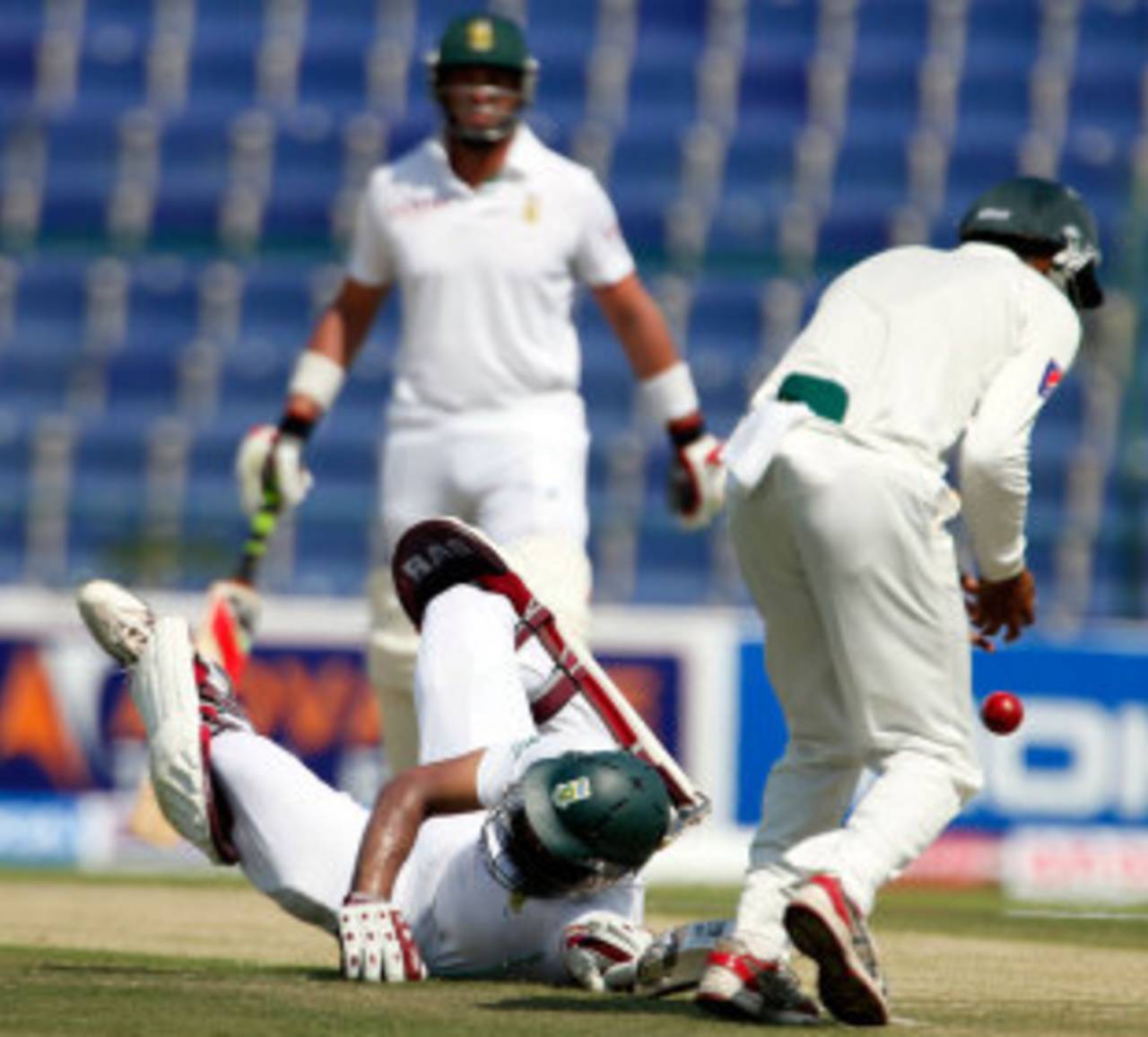Amla, a master of patience and adaptability
Hashim Amla began his innings like he has often done this year - inside the first ten overs - and batted with simplicity and consideration to bring up his 20th Test century
Firdose Moonda in Abu Dhabi
14-Oct-2013

After a mix-up with Jacques Kallis, Hashim Amla tempered his urgency to match the style of his partner • AFP
Perhaps the most remarkable fact about Hashim Amla's triple-century at The Oval last July was that he did not change batting gloves once in the 13 hours and 10 minutes he spent at the crease. He took them off, of course, and dried them at lunch, tea and stumps but put the same pair back on when he resumed his innings.
Amla does not have a Neil McKenzie-type obsession with superstition; it was simply a case of not changing something that was still of perfectly good use. It was about getting rid of the unnecessary, which Amla has become better at as his career has progressed. The results are evident in his significantly less eye-catching back lift and his ability to capitalise when others are not able to.
JP Duminy aside, Amla was the only batsman who looked like he belonged to the No.1 Test team on the first day in Abu Dhabi. The openers struggled against a new-ball assault, which included extra bounce from Mohammad Irfan and movement from Junaid Khan, and Amla found himself walking out before three overs were up. He went on to play with the understanding of a man who had read this book many times before.
Amla has been in before ten overs have been bowled in five out of eight innings this year. Making up for the deficiencies of South Africa's openers has not been a burden, though, but a chance to do something special: Amla has gone past 50 each time and converted two into hundreds.
His patience has been praised at length on these pages and many others. Today Duminy called it "immense," how Amla resisted early in his innings against a tough seam attack and later on, when heat and spin could have worn him down.
Amla relied on simplicity of technique in those testing periods, and an awareness of his off stump allowed him to leave the ball comfortably, when others were more hesitant. It cannot be coincidence that Amla is the only South African Test player with first-class experience in the last month - a stint with Surrey - while his team-mates have either been recovering from injury or playing limited-overs cricket. Duminy also had some first-class cricket, although that was in August against India A.
The assurance that comes with game time was evident in the way Amla approached the practice game in Sharjah, where he attacked the bowling soon after settling, and the way he began his innings here. After ten balls of making the right decisions about what to leave and defend, Amla drove Junaid through mid off. If not for the sluggish outfield, he would not have had to run three.
Once he was satisfied that there were no dangers in the pitch, Amla wanted to get on with scoring. After pushing into the covers, he set off quickly for a run and had to be sent back by Jacques Kallis, a man who prefers to take his time. He was nearly run out. Amla had been part of several misunderstandings between the wickets last summer, and although he couldn't explain why, his enthusiasm for getting a move-on may be behind it.
After being reminded of Kallis' more leisurely preference, Amla adjusted to meet his partner's pace of scoring boundaries when they were available and ambling runs at other times. Amla has excelled at adapting to the tempo of his partner, which makes playing his own game easier, irrespective of who is with him.
When AB de Villiers, who found rhythm immediately, came in, Amla raised his strike rate from 44 to 60, the highest of his innings. With Duminy, who was making a comeback to Test cricket after 11 months, Amla assumed responsibility and scored in more measured fashion, allowing his partner time to feel comfortable.
Duminy said having someone of Amla's quality at the other end made batting easier. Amla is calm on the outside but intense within. Batting may seem as easy as breathing to him, but when he is out there he is thinking of ways for both he and his partner to profit.
If Amla sees that his partner has taken a liking to a certain bowler, he will happily let him have the strike. Duminy was enjoying playing the spinners and there was a five-and-half over period in which Amla faced just six balls.
Amla approached his century in his typical method - slowly. He spent 30 balls in the 90s and saw Duminy depart in that time. Soon after he enjoyed his 20th hundred, Faf du Plessis was out and Amla had to consolidate again. He let Robin Peterson and particularly Dale Steyn play with freedom, in the knowledge that he was there to hold fort. He saw off the second new ball with the same focus that he used for the first and will be back on the second morning to try and complete South Africa's escape.
Overnight, Amla is unlikely to have any anxious thoughts. He may enjoy a latte, one his favourite refreshments, and begin tomorrow as though he was batting for the first time. These are all indicators that Amla does not want for a lot to do his job properly. Duminy confirmed it. "All he basically needs is a sip of lukewarm water, even in that heat, and a towel on his head and he is pretty good," Duminy said. A change of batting gloves? Don't be silly.
Firdose Moonda is ESPNcricinfo's South Africa correspondent